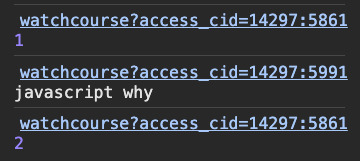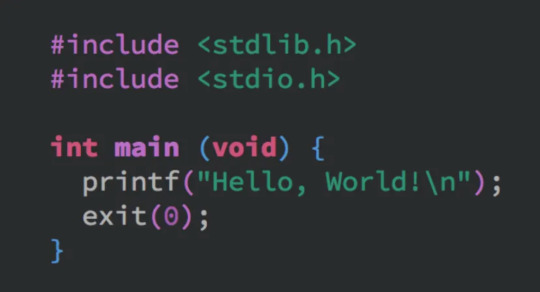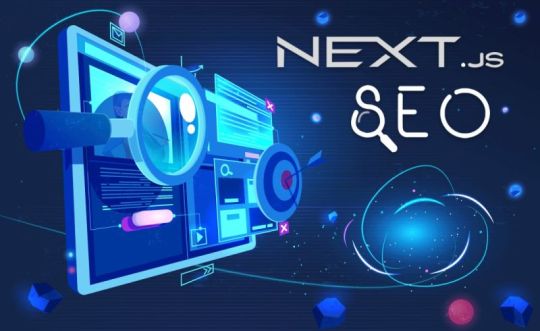#structures in javascript
Explore tagged Tumblr posts
Text
Normally I just post about movies but I'm a software engineer by trade so I've got opinions on programming too.
Apparently it's a month of code or something because my dash is filled with people trying to learn Python. And that's great, because Python is a good language with a lot of support and job opportunities. I've just got some scattered thoughts that I thought I'd write down.
Python abstracts a number of useful concepts. It makes it easier to use, but it also means that if you don't understand the concepts then things might go wrong in ways you didn't expect. Memory management and pointer logic is so damn annoying, but you need to understand them. I learned these concepts by learning C++, hopefully there's an easier way these days.
Data structures and algorithms are the bread and butter of any real work (and they're pretty much all that come up in interviews) and they're language agnostic. If you don't know how to traverse a linked list, how to use recursion, what a hash map is for, etc. then you don't really know how to program. You'll pretty much never need to implement any of them from scratch, but you should know when to use them; think of them like building blocks in a Lego set.
Learning a new language is a hell of a lot easier after your first one. Going from Python to Java is mostly just syntax differences. Even "harder" languages like C++ mostly just mean more boilerplate while doing the same things. Learning a new spoken language in is hard, but learning a new programming language is generally closer to learning some new slang or a new accent. Lists in Python are called Vectors in C++, just like how french fries are called chips in London. If you know all the underlying concepts that are common to most programming languages then it's not a huge jump to a new one, at least if you're only doing all the most common stuff. (You will get tripped up by some of the minor differences though. Popping an item off of a stack in Python returns the element, but in Java it returns nothing. You have to read it with Top first. Definitely had a program fail due to that issue).
The above is not true for new paradigms. Python, C++ and Java are all iterative languages. You move to something functional like Haskell and you need a completely different way of thinking. Javascript (not in any way related to Java) has callbacks and I still don't quite have a good handle on them. Hardware languages like VHDL are all synchronous; every line of code in a program runs at the same time! That's a new way of thinking.
Python is stereotyped as a scripting language good only for glue programming or prototypes. It's excellent at those, but I've worked at a number of (successful) startups that all were Python on the backend. Python is robust enough and fast enough to be used for basically anything at this point, except maybe for embedded programming. If you do need the fastest speed possible then you can still drop in some raw C++ for the places you need it (one place I worked at had one very important piece of code in C++ because even milliseconds mattered there, but everything else was Python). The speed differences between Python and C++ are so much smaller these days that you only need them at the scale of the really big companies. It makes sense for Google to use C++ (and they use their own version of it to boot), but any company with less than 100 engineers is probably better off with Python in almost all cases. Honestly thought the best programming language is the one you like, and the one that you're good at.
Design patterns mostly don't matter. They really were only created to make up for language failures of C++; in the original design patterns book 17 of the 23 patterns were just core features of other contemporary languages like LISP. C++ was just really popular while also being kinda bad, so they were necessary. I don't think I've ever once thought about consciously using a design pattern since even before I graduated. Object oriented design is mostly in the same place. You'll use classes because it's a useful way to structure things but multiple inheritance and polymorphism and all the other terms you've learned really don't come into play too often and when they do you use the simplest possible form of them. Code should be simple and easy to understand so make it as simple as possible. As far as inheritance the most I'm willing to do is to have a class with abstract functions (i.e. classes where some functions are empty but are expected to be filled out by the child class) but even then there are usually good alternatives to this.
Related to the above: simple is best. Simple is elegant. If you solve a problem with 4000 lines of code using a bunch of esoteric data structures and language quirks, but someone else did it in 10 then I'll pick the 10. On the other hand a one liner function that requires a lot of unpacking, like a Python function with a bunch of nested lambdas, might be easier to read if you split it up a bit more. Time to read and understand the code is the most important metric, more important than runtime or memory use. You can optimize for the other two later if you have to, but simple has to prevail for the first pass otherwise it's going to be hard for other people to understand. In fact, it'll be hard for you to understand too when you come back to it 3 months later without any context.
Note that I've cut a few things for simplicity. For example: VHDL doesn't quite require every line to run at the same time, but it's still a major paradigm of the language that isn't present in most other languages.
Ok that was a lot to read. I guess I have more to say about programming than I thought. But the core ideas are: Python is pretty good, other languages don't need to be scary, learn your data structures and algorithms and above all keep your code simple and clean.
#programming#python#software engineering#java#java programming#c++#javascript#haskell#VHDL#hardware programming#embedded programming#month of code#design patterns#common lisp#google#data structures#algorithms#hash table#recursion#array#lists#vectors#vector#list#arrays#object oriented programming#functional programming#iterative programming#callbacks
20 notes
·
View notes
Text
Exploring Quantum Leap Sort: A Conceptual Dive into Probabilistic Sorting Created Using AI
In the vast realm of sorting algorithms, where QuickSort, MergeSort, and HeapSort reign supreme, introducing a completely new approach is no small feat. Today, we’ll delve into a purely theoretical concept—Quantum Leap Sort—an imaginative algorithm created using AI that draws inspiration from quantum mechanics and probabilistic computing. While not practical for real-world use, this novel…
#AI#algorithm#amazon#chatgpt#coding#computer science#css#data-structures#DSA#engineering#google#heapsort#insertionsort#javascript#mergesort#new#programming#python#quicksort#radixsort#sorting#tech#tesla#trending#wipro
2 notes
·
View notes
Text


a tragedy in 2 acts.
#pretentious csharp/asp.net brogrammer types be like#'lol webdev is not Real Programming ur job is easy unlike mine' alright listen up motherfucker#spend a day writing exclusively vanilla javascript & you will end that day by walking silently into the gOD DAMN SEA.#you bask in the innocent comfort of being able to trust that your code will always happen top to bottom in that order lolol you are WEAK#jobblogging#data structures for assholes#(this is the stupidest potential supervillain origin story but like if it happened i WOULD understand)
6 notes
·
View notes
Text
Server-Side vs. Client-Side Rendering: Google Recommendation
Discover what Google’s Martin Splitt says about server-side vs. client-side rendering, structured data, and how AI crawlers handle JavaScript. Learn SEO best practices in 2025. Server-Side vs. Client-Side Rendering: What Google Recommends Server-Side vs. Client-Side Rendering Understanding how Google processes JavaScript content is essential for modern SEO. In a recent interview with Kenichi…
#AI crawler Google#client-side rendering#CSR use cases#Gemini crawler#Google SEO recommendation#JavaScript SEO#Martin Splitt rendering#rendering for SEO#SEO in 2025#SEO rendering strategy#server-side rendering#SSR benefits#SSR vs CSR#structured data#Web Rendering Service
0 notes
Text
If you know about search engine optimization (SEO), you've probably encountered with schema markup. But what is schema markup, and why does it essential? More importantly, how does it impact your search engine rankings? In this guide, we'll break down everything you need to know about schema markup and explain why it plays a important role in boosting your SEO performance.
#cubicalseo#Alexa schema markup#schema markup#boost your visibility#3 formats for schema markup#script tag#JavaScript object notation#ranking factor in Googles algorithm#structured data markup helper#algorithms and guidelines#FAQ schema
1 note
·
View note
Text
Mastering Medium Level LeetCode Problems: A Comprehensive Guide for Interview Preparation
Introduction Are you preparing for technical interviews and looking to strengthen your problem-solving skills? Look no further than medium level LeetCode problems. These problems strike the perfect balance between complexity and accessibility. They require a deeper understanding of algorithms and data structures while still being manageable within a reasonable time frame. In this guide, we will…
#algorithms#data structures#interview preparation#JavaScript#LeetCode#medium level LeetCode problems#Problem Solving
0 notes
Text
i'm poking around through RPG Maker MV's programming and... actually sort of understanding it? proud!!
#key speaks#i'm not too familiar with JavaScript#but i did learn object oriented programming in Java#and have done coding in Python and a teeny bit of C sharp#so it's moderately familiar and i understand most of the core structure#proud!#gonna keep going through the code tomorrow#it's getting late and i had to make myself stop for the night#i'm making mental notes of all the places in the code i'd maybe want to tweak to do more what i want them to#and the places that would have been necessary to change for some plug ins i've seen around#that object oriented programming class actually taught me a lot!#even if that professor wasn't the best#i appreciate the extra work he made us do now#(now that i can apply those concepts when it's not for a grade)
1 note
·
View note
Text
Ship tag drop. 💜
#//lunchbreak so it's time for a quick few posts while i can!#//gimme a break javascript is the only coding language im reasonably able to use lol so that's why i went with it for his tag structure#//more tags might be upcoming if you're lucky and if Events Transpire the way it's been tentatively plotted w some folx <:)#cobalt's talking shit#⤙ let 💜 ; 💜 = Starscream ; ⤚#⤙ let 💜 ; 💜 = Soundwave ; ⤚#⤙ let 💜 ; 💜 = Optimus ; ⤚
1 note
·
View note
Text
Purecode reviews |JavaScript directly within the component structure
These differences allow developers to manipulate the DOM using JavaScript directly within the component structure, in contrast to the separated manipulation seen in HTML opening and closing tags, enabling more sophisticated interactions and updates.
#purecode#purecode software reviews#purecode ai company reviews#purecode ai reviews#purecode company#purecode reviews#JavaScript#component structure
0 notes
Text
"Mastering C Programming: A Comprehensive Guide for Beginners and Experts"
Understanding C Programming: The Foundation of Modern Software Development
C programming, developed in the early 1970s by Dennis Ritchie at Bell Labs, is one of the most enduring and influential programming languages in the history of computing. Its design has directly influenced many other popular languages such as C++, Java, and Python. Despite the emergence of numerous high-level programming languages, C remains a cornerstone in both academic and professional software development environments due to its efficiency, control, and widespread use in system-level programming.

The Essence of C Programming
C is a general-purpose programming language that is particularly well-suited for system programming, including the development of operating systems, compilers, and embedded systems. It provides low-level access to memory through the use of pointers, which allows for efficient manipulation of data and memory management. This is one reason why the UNIX operating system, originally written in assembly language, was eventually rewritten in C.
The syntax of C is concise and powerful. Its constructs map efficiently to typical machine instructions, which makes it an ideal language for performance-critical applications. The simplicity of C's syntax, compared to other languages at the time of its creation, made it easier to learn and use while still being robust enough to handle complex programming tasks.
Key Features of C
Portability: One of the primary reasons for C's enduring popularity is its portability. Programs written in C can be compiled and run on different types of computers with little or no modification, which is crucial in today's diverse computing environments.
Efficiency: C is known for producing fast and efficient code. Its low-level capabilities allow programmers to write code that executes quickly and uses system resources judiciously. This makes it an excellent choice for performance-sensitive applications.
Modularity: C encourages the modular design of software. Functions in C can be defined and called independently, which makes code easier to understand, maintain, and reuse. This modularity is further enhanced by the use of header files and libraries.
Rich Library Support: The standard C library provides a rich set of built-in functions for performing common tasks, such as input/output operations, string manipulation, mathematical computations, and memory management. This extensive library support accelerates the development process.
C in Modern Context
Despite being over four decades old, C remains relevant in modern computing. It is extensively used in developing firmware and embedded systems, where direct hardware manipulation is required. The language's influence is also evident in many contemporary programming languages. For example, C++ was developed as an extension of C to include object-oriented features while maintaining C's efficiency and low-level capabilities.
Learning C provides a strong foundation for understanding computer science concepts and principles. Many educational institutions use C as an introductory programming language because it teaches fundamental programming techniques, such as variable manipulation, control structures, data structures, and algorithm development, which are applicable to learning other languages.
Conclusion
C programming is more than just a language; it is a gateway to understanding the inner workings of computers and software development. Its efficiency, control, portability, and rich library support make it an indispensable tool for programmers. Whether used in system programming, embedded systems, or as a stepping stone to other languages, C continues to be a fundamental part of the software development landscape. Its influence on modern programming practices and its role in the development of many other languages underscore its importance and enduring legacy in the world of computing.
1 note
·
View note
Text
Get this Programming Languages Mega Software Bundle!
Get this Programming Languages Mega Software Bundle! #sale #coding #programming #education #learning #javascript #python #datastructures #algorithms #git
This bundle of 20+ coding items covers JS, Python, Git, and other critical topics! Use this link to check out the three bundle options with up to 26 items. Looking to build a reference library that’ll cover a wide spectrum of essential programming languages and technologies? This bundle from Packt has you covered. Bone up on the foundational language of web development with Modern JavaScript…

View On WordPress
#C++#data structures#developer#education#git#humble bundle#javascript#js#node.js#programmer#programming#python
0 notes
Text
The Ultimate Guide to Next.js SEO: Expert Tips and Best Practices for Top Google Rankings

Welcome to the ultimate guide to Next.js SEO! Are you looking to optimize your Next.js website for top Google rankings? Look no further! In this extensive guide, we'll delve into professional tips and proven methods that can significantly improve your website's performance in search engine results.
Next.js stands out as a powerful framework for creating fast, server-rendered React applications. However, to fully harness the advantages of Next.js, it's vital to implement effective SEO strategies. That's where we step in!
In this guide, we'll thoroughly explore crucial SEO components, including optimizing metadata, structuring URLs, ensuring responsiveness, conducting keyword research, and more. We'll also provide you with valuable insights on crafting compelling content that's sure to win Google's favor.
With our expertise, you'll acquire the knowledge needed to enhance your Next.js website's visibility to search engines, making it more easily crawlable, indexable, and ultimately boosting its potential ranking. Whether you're an experienced developer or just beginning your journey with Next.js, this guide is essential for anyone aiming to conquer the realm of SEO.
Prepare to optimize your Next.js website like a pro and catapult your rankings on Google!"
#Next.js#SEO#Search engine optimization#search engine result pages#JavaScript#CSS#Breadcrumbs#schema markup#Google's Structured Data Testing Tool#Mobile usability#web analytics tool#Google Search Console#SEMrush#Ahrefs#Mobile optimization#HTML
0 notes
Text
#learn#learn to code#learning#software#applications#development#web#html#css#javascript#arrays#lists#structured#data#design#java#programming#free#paid certificate
1 note
·
View note
Text
When to Use an Array and When to Use a Linked List in JavaScript
Introduction As a JavaScript developer, you are likely familiar with arrays and linked lists. Both of these data structures have their own advantages and use cases. In this article, we will discuss when to use an array and when to use a linked list in JavaScript, along with example code to demonstrate their usage. When to Use an Array Arrays are one of the most commonly used data structures in…
0 notes
Text
Introduction to JavaScript for Beginners: Unlock the Power of Web Development 2023
Welcome to our comprehensive guide on JavaScript for beginners. In this article, we will delve deep into the world of JavaScript, one of the most versatile and widely-used programming languages on the web. Whether you’re an aspiring web developer or simply curious about the fascinating realm of coding, we’ve got you covered. Let’s embark on this exciting journey and unlock the potential of…

View On WordPress
#Back-end#Beginners Guide#Coding Essentials#Control Structures#Data Types#Dynamic Web Pages#Events#Front-end#Functions#Interactive Web#JavaScript#JS Basics#Learning JavaScript#Loops#Modern Web Development#programming#Text Editors#Variables#Web Applications#Web Browsers#web development
0 notes